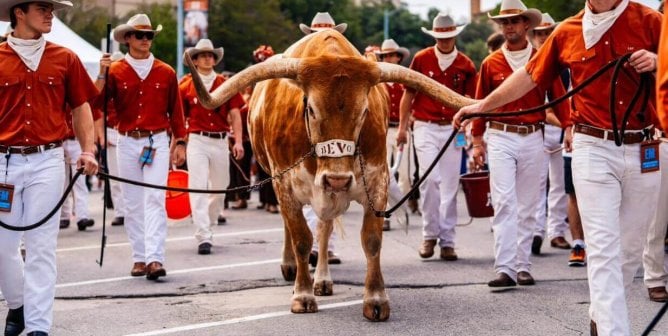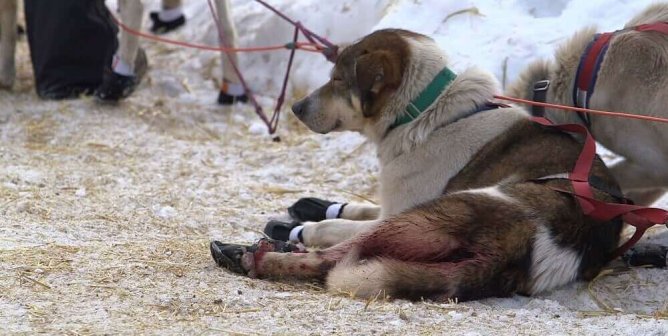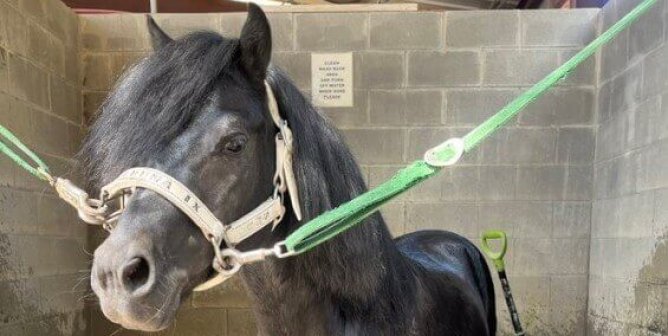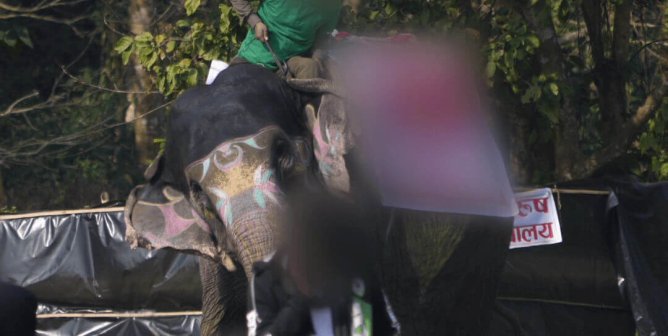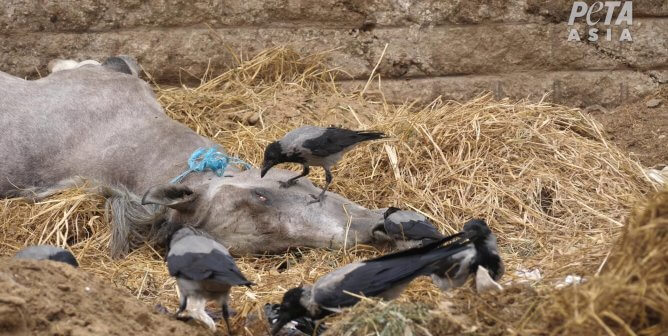The Horseracing Industry: Drugs, Deception and Death
They weigh at least 1,000 pounds, have legs that are supported by ankles the size of a human’s, and are forced to run around dirt tracks at speeds of more than 30 miles per hour while carrying people on their backs.1 Racehorses are the victims of a multibillion-dollar industry that is rife with drug abuse, injuries, and race fixing, and many horses’ careers end in slaughterhouses. A New York Daily News reporter remarked, “The thoroughbred race horse is a genetic mistake. It runs too fast, its frame is too large, and its legs are far too small. As long as mankind demands that it run at high speeds under stressful conditions, horses will die at racetracks.”2
The Starting Gate
Racehorses can cost millions of dollars and are often purchased by syndicates, which may be composed of thousands of members.3,4 There are also trainers, handlers, veterinarians, and jockeys involved, so a horse is rarely able to develop any kind of bond with one person or with other horses. Racehorses travel from country to country, state to state, and racetrack to racetrack, so few horses are able to call one place “home.” Most do not end up in the well-publicized races but are instead trucked, shipped, or flown to the thousands of other races that take place all across the country every year.
Racing to the Grave
Horses begin training or are already racing when their skeletal systems are still growing and are unprepared to handle the pressures of running on a hard track at high speeds.5 Improved medical treatment and technological advancements have done little to remedy the plight of the racehorse. Between 700 and 800 racehorses are injured and die every year, with a national average of about two breakdowns for every 1,000 starts.6 According to The Jockey Club’s Equine Injury Database, nearly 10 horses died every week at American racetracks in 2018.7 At Santa Anita Park in Arcadia, California, 37 horses died within a year, causing the Los Angeles District Attorney to conduct the first-ever criminal investigation into the culpability of trainers and veterinarians who medicate horses for soreness and injury and then put them on the track.8 Strained tendons or hairline fractures can be tough for veterinarians to diagnose, and the damage may go from minor to irreversible at the next race or workout. Horses do not handle surgery well, as they tend to be disoriented when coming out of anesthesia, and they may fight casts or slings, possibly causing further injury. Many are euthanized in order to save the owners further veterinary fees and other expenses for horses who will never race again.
PETA exposed the horse-racing industry’s “breezes” for 2-year-old horses in training—shows in which auction companies show off young horses to potential buyers by pushing them to run a furlong (one-eighth of a mile) at faster speeds than they would ever run in actual races. An equine veterinarian told The Wall Street Journal that the exercises can be “dangerous because they are market driven.” The veterinarian added, “You have a large number of participants in the horse industry … that essentially invest in [racehorses] like stocks.”9
Given the huge investment that owning a horse requires, reported one Kentucky newspaper, “simply sending one to pasture, injured or not, is not an option all owners are willing to consider.”10 Care for a single horse can cost as much as $55,000 per year.11 When popular racehorse Barbaro suffered a shattered ankle at the beginning of the 2006 Preakness, his owners spared no expense for his medical needs, but as The New York Times reported, “[M]any in the business have noted that had Barbaro not been the winner of the Kentucky Derby, he might have been destroyed after being injured.”12 Compare Barbaro’s story to that of Magic Man, who stepped into an uneven section of a track and broke both front legs during a race at Saratoga Race Course. His owner had bought him for $900,000, yet the horse hadn’t earned any money yet and—unproven on the track—wasn’t worth much as a stud, so he was euthanized.13 Eight Belles suffered a similar fate when she broke both her front ankles after crossing the finish line in the 2008 Kentucky Derby.14
Drugs and Deception
Many racehorses become addicted to drugs when their trainers and even veterinarians give them drugs to keep them on the track when they shouldn’t be racing. “Finding an American racehorse trained on the traditional hay, oats, and water probably would be impossible,” commented one reporter.15
“There are trainers pumping horses full of illegal drugs every day,” says a former Churchill Downs public relations director.16 “With so much money on the line, people will do anything to make their horses run faster.” Which drugs are legal varies from state to state, with Kentucky holding the reputation as the most lenient state.17 The New York Sun explained that because “thoroughbreds are bred for flashy speed and to look good in the sales ring … the animal itself has become more fragile” and that “to keep the horses going,” they’re all given Lasix (which controls bleeding in the lungs), phenylbutazone (an anti-inflammatory), and cortiscosteroids (for pain and inflammation).18 Those drugs, although legal, can also mask pain or make a horse run faster. Labs cannot detect all the illegal drugs out there, of which there “could be thousands,” says the executive director of the Racing Medication and Testing Consortium.19
Rick Dutrow, the trainer of 2008 Kentucky Derby and Preakness winner Big Brown, openly admitted to giving his horses Winstrol, a steroid that is illegal for equine use in 10 states, although not in the three that host the Triple Crown. Before it was banned in Pennsylvania, nearly 1,000 horses were tested for steroids and more than 60 percent tested positive. Big Brown’s veterinarian concedes that “without steroids, they’d lose some horses that can’t keep up the pace and race every three weeks or every month.”20 Dutrow was suspended for 10 years in 2011 by the New York racing board for repeated drug violations, although a stay was issued while he appealed the board’s decision, allowing him to continue to work with horses.21
During an undercover investigation conducted in 2013, PETA found that one trainer was subjecting horses to an aggressive, daily regimen of pain-masking drugs and treatments in order to mask the animals’ pain and enhance their performance. For more on this investigation, please visit PETA.org.
Even the ‘Winners’ Lose
Few racehorses are retired to pastures for pampering and visits from caring individuals.
An insurance scandal cost the life of Alydar, who came in second in all three races of the 1978 Triple Crown and fathered many fast horses. After being retired from racing in order to serve as a stud at a Kentucky farm, Alydar was originally believed to have shattered his leg by kicking a stall door and was euthanized when he wasn’t able to maintain a splint.22 Ten years later, an FBI investigation revealed that his leg was deliberately broken when it was tied by a rope to a pickup truck.23
One Colorado State University study found that of 1,348 horses sent to slaughter, 58 were known to be former racehorses.24 PETA rescued a thoroughbred named Coming Home, who is the granddaughter of a Kentucky Derby winner, just after she had been sold at auction for $200 to a meat buyer.
Ferdinand, a Derby winner and Horse of the Year in 1987, was retired to Claiborne Farms and then changed hands at least twice before being “disposed of” in Japan; a reporter covering the story concluded, “No one can say for sure when and where Ferdinand met his end, but it would seem clear he met it in a slaughterhouse.”25 Exceller, a million-dollar racehorse who was inducted into the National Racing Museum’s Hall of Fame, was killed at a Swedish slaughterhouse.26 During an undercover investigation inside Japan’s largest horse slaughterhouse in Kumamoto, PETA captured video footage of a thoroughbred’s last tragic minutes.
Although there are currently no equine slaughterhouses in the U.S., Congress has approved funding for inspections by the U.S. Department of Agriculture (USDA) should any equine slaughterhouses open, paving the way for horse slaughter in the U.S. to resume.27 In the meantime, there is still a horsemeat export industry that sends tens of thousands of horses every year to Canada, Mexico, and Japan for slaughter.28
A 10-month PETA US investigation revealed that the South Korean horseracing industry sends thousands of horses to slaughter, including many American horses and their offspring. South Korea aggressively imports and breeds American racehorses in an effort to raise the quality of its races, on which South Koreans bet US$8 billion annually. U.S. auction houses—including Ocala Breeders’ Sales Company, Fasig-Tipton, and Keeneland—as well as private parties sell approximately 400 horses to South Korea each year at a cost of about $10 million total. But the Korean racing industry discards as many horses as it brings in, and while it “retires” more than 1,600 horses per year, they admit that only about 3% end up at other equestrian facilities. Most are sent to slaughter, usually at the Nonghyup abattoir on Jeju Island, where horsemeat restaurants abound.29 For more on this investigation, please visit PETA.org. Since this investigation, the Stronach Group, a company that manages North American racetracks, has endorsed PETA’s efforts to ban the sale of thoroughbreds to South Korean racing interests and is encouraging “all North American auction companies, breeders, and owners to develop policies that prohibit the sale of Thoroughbred racehorses or brood mares to South Korea without the meaningful and binding assurances that these noble animals will be protected after their racing and breeding careers.”30
Most horses who are sent to those slaughter are forced to endure days of transport in cramped trailers.31 Usually, there is no access to water or food, and injuries are common: A University of California– Davis study of 306 horses destined for slaughter found that 60 of them sustained injuries during transport.32 While veterinarians recommend that horses be offloaded for food and water every four hours while traveling, the USDA allows horses to be shipped for 28 hours without a break.33 Horses are subject to the same method of slaughter as cows, but since horses are generally not accustomed to being herded, they tend to thrash about in order to avoid the pneumatic gun that is supposed to render them unconscious before their throats are cut.34
What You Can Do
In a commentary on the racing industry, a reporter for the Philadelphia Daily News remarked, “It is not something they talk about much in their advertising, but horses die in this sport all the time—every day, every single day.”35 Help stop cruelty in the horseracing industry: Work to ensure that racing regulations are reformed and enforced, lobby against the construction of new tracks, and educate your friends and family members about the tragic lives that racehorses lead. Please urge your legislator to cosponsor the Horseracing Integrity Act to protect horses nationwide from drugging.
References
1 Ted Miller, “Six Recent Horse Deaths at Emerald Downs Spark Concern,” Seattle Post-Intelligencer 8 May 2001.
2 Bill Finley, “Sadly, No Way to Stop Deaths,” New York Daily News 10 Jun. 1993.
3 Emily Feldman, “From Purchase to Post: The Price of Raising a Racehorse,” NBC San Diego, accessed 5 May 2019.
4 Dave Serchuck, “Small Investors Racing To Horse Syndicates,” CNBC 1 Mar. 2013.
5 Glenn Robertson Smith, “Why Racehorses Are Cracking Up,” The Age (Australia) 15 Nov. 2002.
6 Bill Toland, “Horse Racing Has Grim Underside,” Pittsburgh Post-Gazette 10 Jun. 2006.
7John Drape, “Horse Deaths Are Threatening the Racing Industry. Is the Sport Obsolete?,” The New York Times 29 Apr. 2019.
8“Santa Anita Park Begins Winter-spring Season Amid Protest,” ABC 7 29 Dec. 2019.
9 Dionne Searcey, “Not So Fast: Critics Decry Horse-Auction Exercise,” The Wall Street Journal 9 Sept. 2011.
10 Tim Reynolds, “Technology Can’t Prevent Horse Injuries,” The Lexington Herald-Leader 30 Aug. 2001.
11 Ross Kenneth Urken, “How to Invest in a Racehorse Even If You’re Not a Millionaire,” The Street 6 May 2017.
12 William C. Rhoden, “An Unknown Filly Dies, and the Crowd Just Shrugs,” The New York Times 25 May 2006.
13 Rhoden.
14 Associated Press, “Runner-Up Eight Belles Breaks Front Ankles, Euthanized on Track,” 3 May 2008.
15 John Scheinman, “Horses, Drugs Are Racing’s Daily Double,” The Washington Post 27 Apr. 2003.
16 Alex Straus, “Dark Horses,” Maxim May 2002.
17 Janet Patton, “HBPA Proposes Uniform Policy on Drugs in Racing; Horsemen’s Group Targets Maze of State Rules,” The Lexington Herald-Leader 17 Oct. 2001.
18 Max Watman, “So Far, So Good for Barbaro,” The New York Sun 21 May 2006.
19 Scheinman.
20 Bill Finley, “In Horse Racing, Test of Beefed-Up Champions,” The New York Times 2 Jun. 2008.
21 David Grening, “Aqueduct: Dutrow on a Roll With 10-Year Ban on Hold,” Daily Racing Form 22 Nov. 2011.
22 Skip Hollandsworth, “The Killing of Alydar,” Texas Monthly Jun. 2001.
23 Straus.
24 K. McGee et al., “Characterizations of Horses at Auctions and in Slaughter Plants,” Colorado State University Department of Animal Sciences, 2001.
25 “Derby Winner Ferdinand Believed to Have Been Slaughtered in Japan,” Thoroughbred Times 26 Jul. 2003.
26 Allen G. Breed, “Neglect, Slaughter Await Many Former Racehorses,” The Ledger, 20 Nov. 1999.
27 Rene Lynch, “Horse Slaughter Poised to Resume in U.S.—With PETA’s Approval?” Los Angeles Times 1 Dec. 2011.
28 Food and Agriculture Organization of the United Nations, “Horsemeat Slaughtered/Prod Animals (Head),” 2017.
29Ryan Goldberg, “Why Are Good Young Racehorses Ending Up As Meat 7,000 Miles Away?” Deadspin, 2 May 2019.
30“The Stronach Group Joins PETA in Urging Ban on Sale of Horses to South Korea,” Thoroughbred Daily News 16 Dec. 2020.
31 Andrew Wasley, “America’s Secret and Brutal Horsemeat Trade,” Ecologist 18 Mar. 2013.
32 C.L. Stull, “Responses of Horses to Trailer Design, Duration, and Floor Area During Commercial Transportation to Slaughter,” Journal of Animal Science 77 (1999): 2925-33.
33 Michigan State University, “Twenty Eight Hour Law,” Animal Legal and Historical Center Mar. 2018.
34 Kris Axtman, “Horse-Meat Sales Stir Texas Controversy,” The Christian Science Monitor 28 Apr. 2003.
35 Rich Hofmann, “Racing Brings Up the Rear in Safety,” Philadelphia Daily News 23 May 2006.

